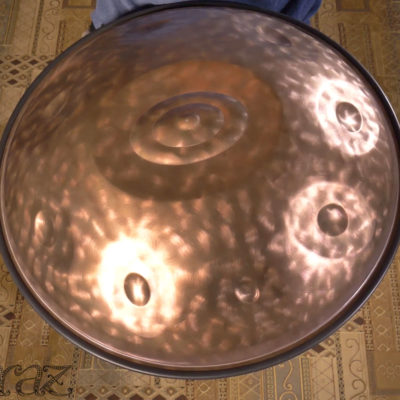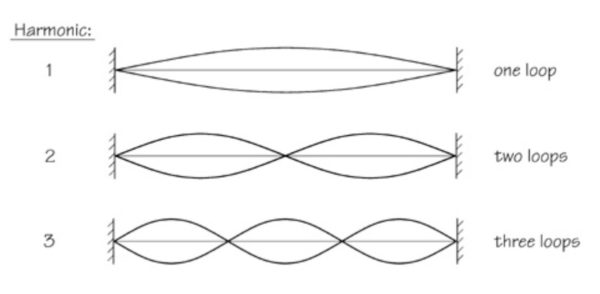Behind the Scenes Research and Design at Saraz
There is only 1 note that is different between some scales. For example, between Minor and Dorian, only the 6th note in the scale is different. This 1 note difference is also true for: Dorian and Mixolydian; Mixolydian and Major; Minor and Harmonic Minor; and many many others. A few times in the past, we have used the same instrument to make 2 or 3 different demonstration videos, especially when opening up a new range of scales. This Saraz however, has taken the record for being 4 different scales with 1 of them being radically different than the others.

This is the story of one R&D Saraz Instrument’s journey
Originally, the instrument was laid out and pressed with very specific sizes of notes to be our first Saraz with an A2 center note and a full scale of A minor around it from A3 to A4. Many of you probably know that we have an individual note form for each note that we offer. There is some leeway, however every step that it is stretched can add exponential tuning work and especially extra work in balancing the timbre of the note and instrument. When I started tuning this shell, I quickly determined the A2 form was ideal. The A2 fell into place easily with a B5 shoulder tone. Then things got especially interesting…
First E2 Saraz with Alternative Harmonics
For a few weeks before starting this instrument, I had been brewing on the possibility of tuning lower notes with alternative harmonics that are higher than the traditional octave long axis and compound 5th short axis. The reason being that this would allow me to tune the note on a much smaller membrane. Those low E2 and F2 notes are HUGE and take up a LOT of space! I have tuned a couple Saraz in the ancient past with alternative harmonics on the center note. Both had compound 3rds instead of compound 5ths on the short axis. They were interesting but obviously didn’t stick because there is something very special about the wave alignment of octaves and 5ths. They simply harmonize in a very fundamental and beautiful way with very basic ratios of wave alignment.
Magic Harmony of Octaves and 5ths
The inspiration for this low note with alternative harmonics came from two other places. Around 2014 or so, I played a Pantheon Steel Halo with a 2nd octave on the short axis. I believe it was an E3 with an E4 long axis and E5 short axis. It sounded surprisingly normal and didn’t catch my attention until Kyle told me how it was different. A year or two later, I played (and tuned) one of the first Panart Gubal instruments. It had an interesting “Port” or “Gu” tuning. There was a fundamental, an octave and a 5th (instead of compound 5th which is 12 notes higher). The frequency relationships in the “Gu” also sounded quite surprisingly normal to my ears. There seems to be a magic harmony between Octaves and 5th, where ever they may fall, because they create the most basic harmonic ratios (1:2, 1:3 and 1:4 in these cases). For visual reference, in the following picture, one can think of the “1” in the ratio as the “one loop”, the “2” in the ratio as the “two loops”, the “3” in the ratio as the “three loops” and so on.

After considering all of this, it dawned on me that the A2 note form was perhaps the best one to test the theory for an E2 fundamental with a compound 5th (B3) long axis and a second octave (E4) short axis. If I was lucky, I could also tune a B5 shoulder tone.
The results? It mostly worked!
With a bit more tuning, I could have gotten both shoulder tone axes to B5 instead of only 1, however I knew this would not be the final destination for this shell so I didn’t get lost in that rabbit hole. Otherwise, it worked great!
One of the first issues I ran into with this E2 however was how wrong the layout of sides were for this center note. So I embarked on changing 5 of the originally intended notes to create an entirely new scale. A couple of those notes were actually more difficult to tune than the center note. This scale was briefly:
E2/ G, A, B, D, E, F#, G, B
It is an interesting variation of E” Celtic” Minor that I may not ever build again in this exact layout for various reasons. Even with the changed layout, it still had too much wild interaction between the center note and B3 that created a ghostly timbre to the B3 especially and was a deal breaker for me. So the instrument got cut open and continued further in it’s musical journey to become the originally intended A Minor with an A2 center note.
First A2 Saraz
Since these were the originally intended notes for the shell, this was quite an easy change! This is a full scale of A minor (and even both B5 shoulder tones fell back into place with this one) (A perfect companion to C Major, D Dorian, and G Mixolydian:
A2/ A, B, C, D, E, F, G, A
After making this video, I decided it was a great opportunity to see how much more I could get out of this instrument. Only a couple times in the past have I changed a note or two to create new scales simply for a video demonstration of what we can build before changing it back to the originally intended scale. This seemed like one of those opportunities. By changing only the F4 to an F#4, it became a full scale of A Dorian (a perfect companion to E Minor or G Major):
A2 Dorian Saraz
A/ A, B, C, D, E, F#, G, A
Yet again, by changing only one more note, the C4 into a C#4, the instrument transforms from A Dorian into A Mixolydian (A perfect companion to D Major and E Dorian):
A2 Mixolydian Saraz
A/ A, B, C#, D, E, F#, G, A
Changing Handpan Notes
Before we start getting emails from people wanting us to change notes, it is worth mentioning that a lot of thought went into these changes. It is rarely ideal to do this without some significant work to balance the timbre. If you listen closely between the A minor and A Dorian videos, you might be able to hear especially how the F# sounds tighter in the Dorian video than the F in the Minor video. These types of issues can grow exponentially with work like this on any instrument.
It is perhaps worth mentioning that by changing only one more note, I could have also made an A Major and an A Harmonic Minor, however I generally try to avoid there being an adjacent half step on the high end because it often leads to cross talk between the two notes. In this layout, both of those options would have created a G# aside the high A. We will likely offer some A Major and A Harmonic Minor variations, but they will need to be a bit different layout to avoid this adjacent half step situation.
Comparing Scales
It was really fun for me to play each of these scales successively in one afternoon. It truly is amazing how much a single note can change the emotion of an instrument as well as how it is played. The chord progressions and patterns also change quite significantly because of only 1 note change!
Thanks so much for going on the Journey with me,
– Mark
Which scale is your favorite?
(BTW, the instrument settled as an A Dorian 😉 )



